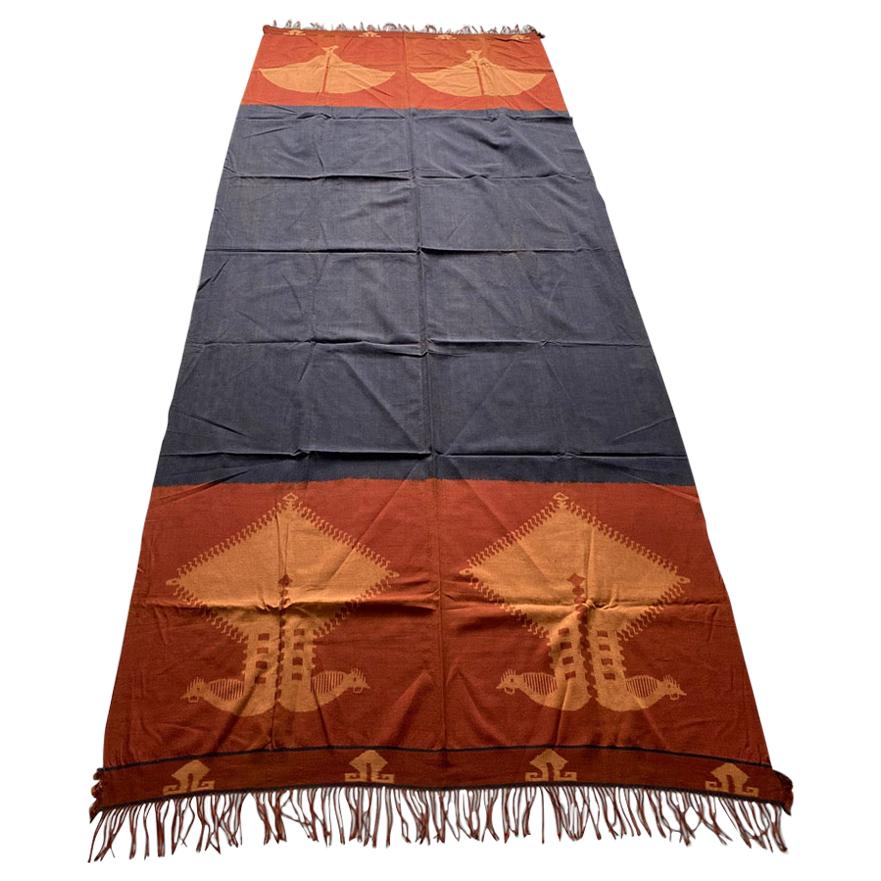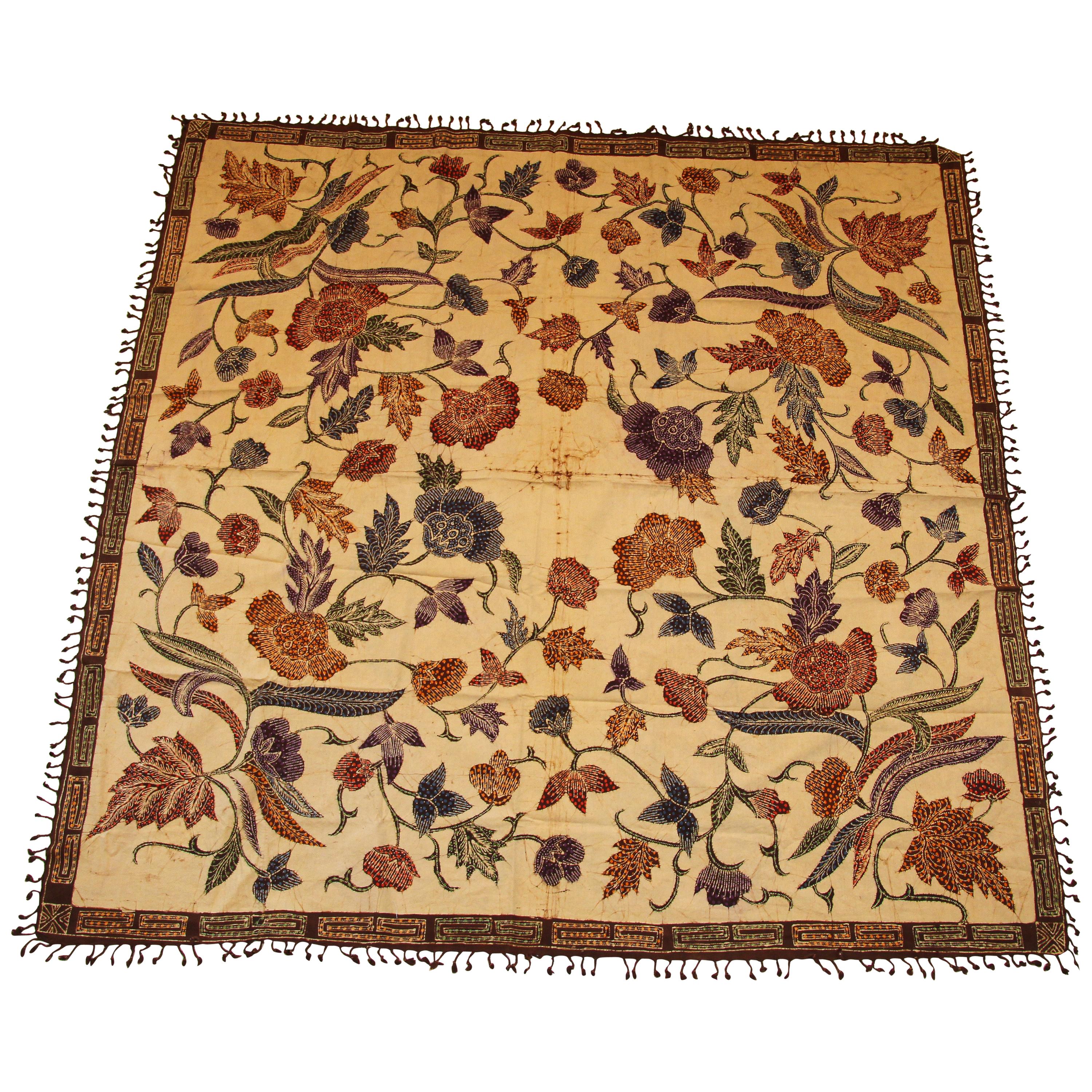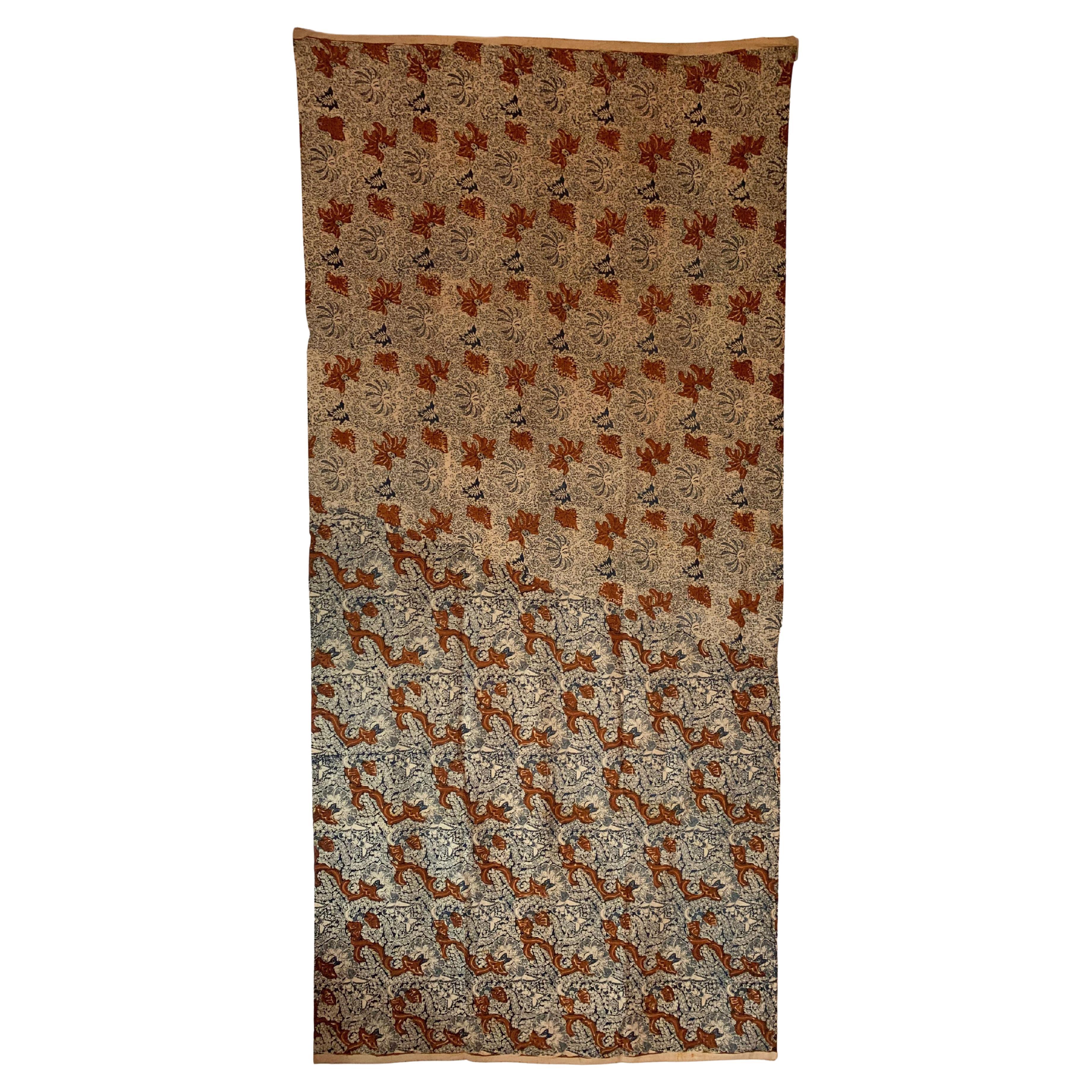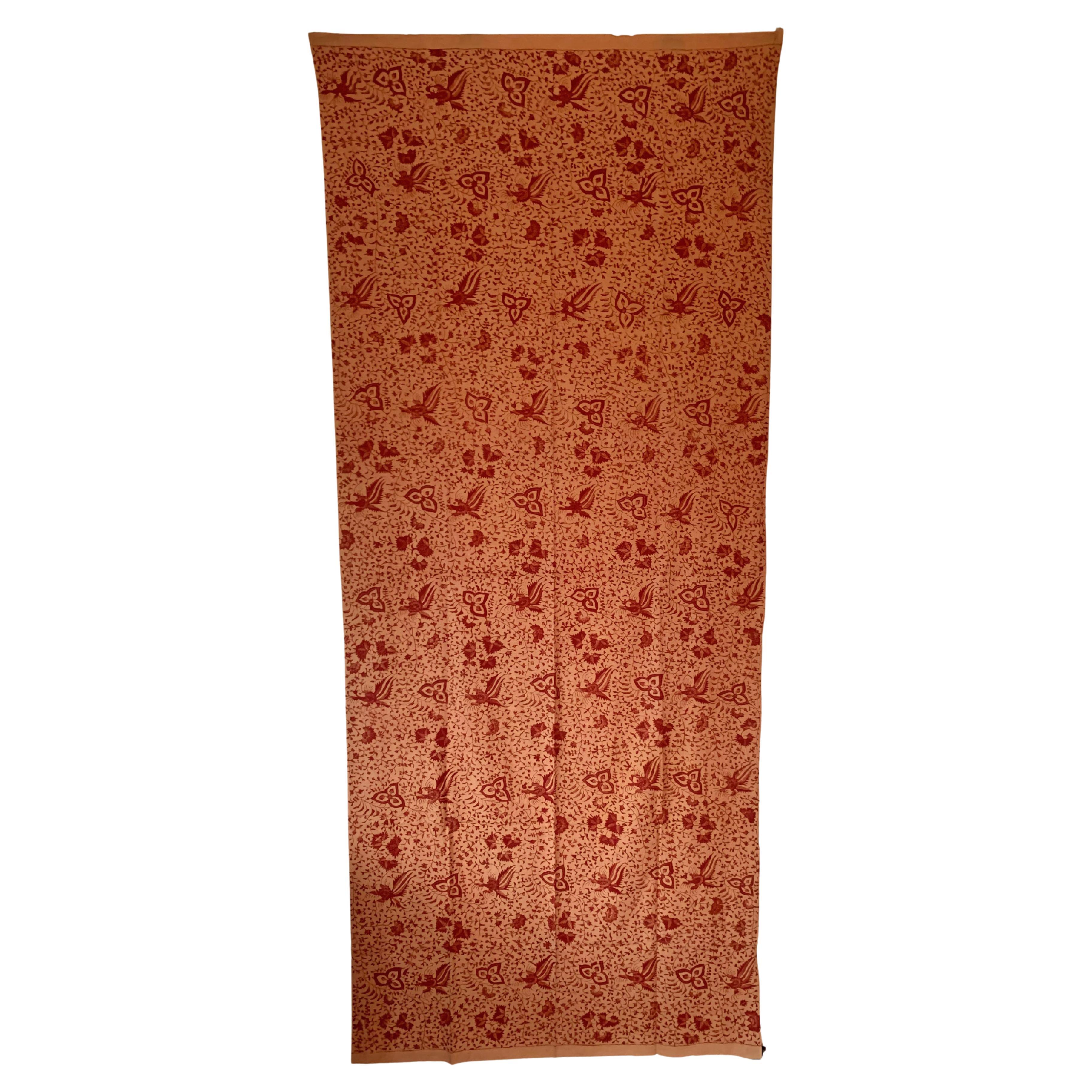Items Similar to African Batik Cloth Natural Hand-woven Hand-Printed Cotton Fabric Ghana 10 Yards
Video Loading
Want more images or videos?
Request additional images or videos from the seller
1 of 12
African Batik Cloth Natural Hand-woven Hand-Printed Cotton Fabric Ghana 10 Yards
About the Item
African Batik Cloth Natural Hand-woven Hand-Printed Cotton Fabric Ghana 10 yards.
Colors are organic earth tone beige and light brown in geometric design.
Non waxed fabric circa 1950s.
Hand made in Ghana Africa.
Museum Quality Original Long Piece.
380 inches, (30 ft 10 yards Long) x 46 inches Inches Wide( 4ft).
Could be use to make pillows or upholstery.
History of Batik in Africa:
Batik, a traditional fabric art technique, has a rich history in Ghana, West Africa. The practice of batik involves using wax to create intricate patterns on fabric, which is then dyed to achieve the desired design. While batik has its origins in Asia, particularly in Indonesia, it has been embraced and adapted by various African countries, including Ghana.
In Ghana, batik-making can be traced back to the mid-20th century when it gained popularity as a form of traditional textile art. The craft was introduced by artists and artisans who were inspired by the vibrant and expressive nature of batik. These early practitioners experimented with different designs, colors, and patterns, infusing local themes and motifs into their creations.
Over time, batik became an important part of Ghanaian culture and identity. It is not only used for clothing but also for various decorative and functional items such as wall hangings, tablecloths, and accessories. The art form often reflects the rich cultural heritage of Ghana, incorporating symbols, proverbs, and traditional stories into the designs.
Ghanaian batik artists often employ a combination of traditional and contemporary elements, creating a unique fusion of styles. The process of making batik involves applying hot wax to the fabric using various tools to create the desired patterns. The wax acts as a resist, preventing dye from penetrating the waxed areas. After dyeing, the wax is removed, revealing the intricate designs on the fabric.
Today, batik-making in Ghana continues to thrive as both a traditional craft and a form of artistic expression. Many artisans and designers draw inspiration from Ghana's diverse cultural landscape, incorporating elements from different regions and ethnic groups into their batik creations. The art form has also gained international recognition, with Ghanaian batik products being sought after both locally and abroad.
In summary, the history of batik in Ghana is a testament to the creativity and adaptability of artists who have embraced and transformed this traditional technique into a vibrant and culturally significant art form within the country.
HISTORY OF BATIK
In the mid-nineteenth century, the Belanda Hitam, or "Black Dutchmen," are said to have introduced batik to West Africa after serving as indentured soldiers for the Dutch in Indonesia. Returning from their conscriptions with trunks of fine Javanese batik, the opulent patterns captured the imagination of their friends and relatives. However, textile history is complex, and only a handful of recruits returned to West Africa with batik due to delayed payments.
Batik, with roots traced to Egyptian mummies, is a tradition found globally, from Southeast Asia to Japan and India. Europeans, particularly the Dutch, played a significant role in industrializing batik from the seventeenth century onward.
In West Africa, Dutch Scholar Ineke van Kessel suggests that batik arrived from India over trans-Saharan routes. Local populations, like the Yoruba in Nigeria, incorporated wax printing into their textiles. European traders brought wax and non-wax fabrics to West Africa in the seventeenth century, targeting a population ready for their consumption. European designers adapted prints for the African market, tailoring designs to each region and port.
Today, batik, both handcrafted and in derivative roller prints, is widespread and cherished across West Africa. Patterns range from abstract geometry to figurative images, serving as a form of expression and communication for individuals, conveying marital status, mood, and even political and religious beliefs. While wax prints were initially produced in Europe until the 1960s.
- Dimensions:Height: 360 in (914.4 cm)Width: 45.5 in (115.57 cm)Depth: 0.05 in (1.27 mm)
- Style:Folk Art (In the Style Of)
- Materials and Techniques:
- Place of Origin:Ghana
- Period:
- Date of Manufacture:1950
- Condition:
- Seller Location:North Hollywood, CA
- Reference Number:
About the Seller
5.0
Platinum Seller
These expertly vetted sellers are 1stDibs' most experienced sellers and are rated highest by our customers.
1stDibs seller since 2011
2,639 sales on 1stDibs
Typical response time: 1 hour
- ShippingRetrieving quote...Ships From: North Hollywood, CA
- Return PolicyA return for this item may be initiated within 7 days of delivery.
More From This SellerView All
- Woven African Tribal Bogalan Mud Cloth TextileLocated in North Hollywood, CAHandwoven Bogolan mud cloth textile from Mali, Africa, Bambara. It is a handwoven tribal cotton fabric traditionally dyed with fermented mud. Woven Afr...Category
20th Century Malian Folk Art Tribal Art
MaterialsCotton
- Vintage Hand Painted Floral Batik from Sidoarjo East JavaLocated in North Hollywood, CAHand Drawn Indonesian Batik with Floral Design, Made in Indonesia, Full Batik Tulis Madura, Indonesian Batik Fabric. A beautiful, vintage hand made Batik ...Category
Mid-20th Century Indonesian Folk Art Textiles
MaterialsCotton
- Berber Tribal North Africa Moroccan Burnous Wool CapeBy Berber Tribes of MoroccoLocated in North Hollywood, CAMoroccan Akhnif Berber hooded burnous cape in handwoven brown wool. Tribal traditional cape with hood handwoven in the High Atlas Mountains. Tribal design in the back, great shades of brown natural organic wool colors. The burnus (also called a selham) is long, hooded cloak...Category
20th Century Moroccan Folk Art Textiles
MaterialsWool
- Phulkari Bawan Bagh Wedding Shawl, Silk Embroidery on Cotton, Punjab IndiaBy RajhastaniLocated in North Hollywood, CAA rare pattern embroidered in silk on a hand loomed cotton background. Punjab is known for its Phulkaris. The embroidery is done with floss silk thread on coarse handwoven cotton fab...Category
Early 20th Century Indian Folk Art Textiles
MaterialsCotton, Silk
- Antique Moroccan Hand Tooled Berber Leather Babouches ShoesBy Berber Tribes of MoroccoLocated in North Hollywood, CAAntique Moroccan leather slippers, known as babouches are handmade from leather dyed in red and green and embroidered in silk wool thread with ethnic floral design, hand-sewn sole. H...Category
Early 20th Century Moroccan Folk Art Textiles
MaterialsLeather
- Woven Cashemere Paysley Throw Textile Shawl, 1850-1890Located in North Hollywood, CAA very large silk cashmere paisley throw shawl, circa 1860s, made with the rafugars method of construction, hand loomed pieces that are painstakingly han...Category
Antique 19th Century Indian Victorian Pillows and Throws
MaterialsSilk
You May Also Like
- Andrianna Shamaris Minimalist Antique Hand Woven Cotton TextileBy Andrianna ShamarisLocated in New York, NYBold contrasting tones on this minimalist ikat from Toraja Land. Ikat is an ancient technique which is used to add patterns to textiles. The designs are created in the yarns rather than on the finished cloth, which results with the pattern on both sides in bold contrasting colors.This beautiful, extra long textile...Category
Early 20th Century Indonesian Tribal Quilts and Blankets
MaterialsCotton
- Hand-Drawn Batik Textile, from Java IndonesiaLocated in Jimbaran, BaliA fine example of a batik textile from Solo, Java, Indonesia. This textile features wonderful detailing & contrast. It features a wonderful array of flor...Category
Early 2000s Indonesian Other Textiles
MaterialsCotton
- Hand-Drawn Batik Textile, from Java IndonesiaLocated in Jimbaran, BaliA fine example of a batik textile from Solo, Java, Indonesia. This textile features wonderful detailing & contrast. It features a wonderful array of flor...Category
Early 2000s Indonesian Other Textiles
MaterialsCotton
- Hand-Drawn Batik Textile, from Java IndonesiaLocated in Jimbaran, BaliA fine example of a batik textile from Solo, Java, Indonesia. This textile features wonderful detailing & contrast. It features a wonderful array of flor...Category
Early 2000s Indonesian Other Textiles
MaterialsCotton
- Hand-Drawn Batik Textile, from Java IndonesiaLocated in Jimbaran, BaliA fine example of a batik textile from Solo, Java, Indonesia. This textile features wonderful detailing & contrast. It features a wonderful array of flor...Category
Early 2000s Indonesian Other Textiles
MaterialsCotton
- Contemporary Handblock Printed Natural Dyed Yellow Cotton Tablecloth, IndiaLocated in Copenhagen K, DKIndia, Contemporary Handblock printed natural dyed cotton tablecloth. H 273 x W 226 cmCategory
2010s Indian Textiles
MaterialsCotton
Recently Viewed
View AllMore Ways To Browse
Textiles Sewn And Woven
Uzbek Suzani Bed Covers
Asian Art Wall Hanging
Cream Embroidered Table Cloth
Kesi Embroidery
Linen Embroidered Hanging Flat Weave
Min Dynasty
Falcon Scarves
Kaaba Curtain
Suzani Bed Spread
Antique Chinese Silk Fan
Antique Ottoman Vest
Chinese Dragon Kimono
Hooded Djellaba
Ikat Hinggi
Japanese Wedding Robed
Antique Chinese Silk Embroidery Wall Hanging
Japanese Fireman Jacket





